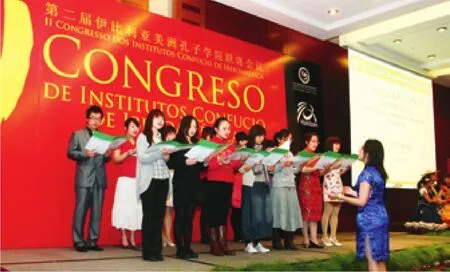Complementary Partners
2010-10-14BySUNYANFENG
By SUN YANFENG
Complementary Partners
By SUN YANFENG
Five decades on, China’s relationship w ith Latin American and Caribbean countries is grow ing stronger

T he trade vo lum e betw een China and Latin American and Caribbean countries has surpassed $100 billion,and China has become that region’s second largest trading partner.Their cooperation has increased across the board, including in new energy, climate change,nuclear energy and agricultural technology.
In September 1960, China forged diplomatic ties w ith Cuba, heralding the beginning of relations w ith Latin American and Caribbean countries. Half a century has now passed, and it is high time for the two sides to create new plans for the future development of their relations.
Features
Over the past 50 years, relations between China and Latin American and Caribbean countries have taken a unique course.
Unlike China’s relations w ith other regions and countries, its relations w ith Latin American and Caribbean countries have a natural foundation for strategic cooperation, as the two sides have neither territorial disputes nor core interest confl icts.
Currently, they are each faced w ith the task of economic and social development and are dealing w ith common problems in governance concepts and development models. As they develop, both are suffering from political, econom ic, trade and technology barriers imposed by developed countries. A number of emerging Latin American countries, such as Brazil, are faced with the same question as China:How can a nation achieve peaceful grow th under Western pressure?
In the 1960s and 1970s, the two sides were mainly connected by the struggle against world hegemony. For instance, China cooperated with a number of socialist or left-wing countries in the region in their fight against U.S. hegemony.China’s relations with Cuba served as a typical model during this period.
In the 1970s, relations between China and Latin American and Caribbean countries bore the mission of breaking the diplomatic blockade of the United States and the Soviet Union. In this period, China established diplomatic relations with major countries in the region such as Brazil, Mexico and Argentina.
After that, in the 1980s and 1990s, the two sides embraced a period of all-around development, featuring increased high-level political exchanges, the beginning of cultural, scientific and technological cooperation,and an increase in citizen exchanges.

HI-TECH TOURS: Visito rs tour the boo ths o f Chinese com panies at an international refrigeration exhibition in Sao Pau lo, Brazil, on Sep tem ber 25, 2009
After entering the 21st century, China and Latin American and Caribbean countries got into a pattern of rapid economic development,and bilateral economic and trade cooperation took center stage. The trade volume between the two sides increased from tens of millions of dollars shortly after they established diplomatic relations to more than $100 billion in 2009.Scientific, technological and cultural cooperation is also strengthening. China has intensified its cooperation w ith Brazil in meteorological satellites, and has established Confucius Institutes—educational institutions devoted to spreading know ledge about Chinese language and culture—in many countries in the region.Clearly, the relationship between China and Latin American and Caribbean countries is becoming a comprehensive partnership.
The most fundamental cooperation basis between the two sides lies in the complementary nature of their economies. Latin American nations control rich resources, including Venezuelan oil, Brazilian iron ore and soybeans and Chilean copper. These resources are their major export products and the main force pushing them toward further econom ic grow th.
China manufactures a large number of mechanical and electrical products, as well as light industry products, which are demanded by Latin American markets.The development of economic and trade cooperation between China and Latin American and Caribbean countries in the past 50 years—and especially in the past 10 years—serves as sound proof.
Changes
Chinese President Hu Jintao’s 2004 Latin America visit, spurred even more cooperation opportunities for China and Latin America.
In light of the big adjustments and reforms of the world, multi-polarization has become irreversible. It is more important than ever for China to have a clear mind of the significance of its cooperation w ith Latin America, especially w ith major countries in the region. So far, China has established strategic partnerships w ith Brazil, Argentina, Mexico, Venezuela and Peru. China’sPolicy Paper on Latin America and the Caribbean, which was issued in November 2008, indicated that it had already regarded the region as strategically important.
A fter the financial crisis, global systems faced readjustment. China, Brazil, Argentina and Mexico, which are all members of the Group of 20 major economies, have enjoyed excellent interaction, consultation and cooperation in the reform of the global financial system.
Such cooperation w as also seen between China and Brazil under the BASIC(Brazil, South Africa, India and China) and BRIC (Brazil, Russia, India and China)frameworks, w ith regard to climate change negotiations and the reform of the world economic order. This cooperation has transcended bilateral or regional dimensions and has become globally significant.
What’s more, China now has more partners in the region. For a long period after China and Latin American and Caribbean nations established diplomatic relations, ideological confl icts and the Taiwan question seriously constrained the development of bilateral relations.
As China’s international status and com p rehensive national strength have increased—and w ith the ease of relations across the Taiwan Straits since 2008—China has faced fewer restrictions while developing relations with countries in the region.
At present, left-w ing countries like Cuba and Venezuela, right-w ing countries like Colombia and Chile and centrist countries like Brazil all regard the promotion of relations w ith China as a foreign policy priority.
Meanwhile, many countries that have not yet established diplomatic relations w ith China have begun to soften in their stances toward China. Their econom ic, trade and nongovernmental exchanges w ith China are also increasing.
Diversification
Although the two sides have achieved a great deal in the field of trade, trade cooperation alone w ill not fully realize the vast potential between them. It is urgent for them to continue to deepen and broaden their business ties, and to make adjustments to relevant systems. So far,China has signed free trade agreements w ith Chile, Peru and Costa Rica. In the meantime,diversification of trade and economic relations is on the horizon.
For instance, China and Venezuela established a joint development fund, hoping to promote infrastructure construction cooperation through oil trade. China lent $10 billion to Petrobras, Brazil’s largest oil company, in return for a guaranteed oil supply for a decade, a win-win outcome for both countries. China also signed a 70-billion-yuan ($10.51 billion) currency swap agreement w ith Argentina. According to this agreement, Argentina did not need to use the dollar as an intermediary currency, but could use the yuan directly when importing goods from China.
In the meantime, China encouraged its state-owned and private enterprises to invest in Latin American countries’ resource and processing industries. It also tried to shift from importing basic raw materials to importing primarily processed products. In this way, this shift would help meet the needs of both parties w ith a single production chain.
China also conducted econom ic and techno logical cooperation w ith Cuba,Suriname, Mexico, Ecuador and other countries in the form of aid, project contracting and labor exports.

LOVE OF LANGUAGE: Studen ts from the loca l Con fuc ius Institu te in Chile’s coasta l c ity o f Vina Del Mar dem onstrate their Chinese language abilities during the opening cerem ony o f the Second Cong ress o f Con fuc ius Institu tes in Ibero-Am erica on Ju ly 17, 2010
Five decades since they fi rst established diplomatic relations, cooperation between China and Latin America has climbed to a new high. In the future, the two should continue to work together, striving to become all-weather political allies, as well as trade,scientific and technological partners.
Politically, China and Latin American countries should continue w ith the current interactive policy. Especially, China should strengthen cooperation w ith emerging countries in the region in reform ing the global financial system, coping w ith climate change and reshaping the international trade regime.
Cooperation between big developing countries—China and Brazil, for instance—can effectively enhance the influence of these countries and promote the balance of power between the developed world and the developing world.
The two sides should also continue to strengthen trade and investment ties, promoting trade through investment and optim izing investment through trade. China has rich capital and a large market, while Latin American countries possess abundant resources. They could complement each other.In this way, they could not only promote their bilateral econom ic and trade relations,but also ensure the stability of their political relations. For instance, Argentina and Colombia, which are rich in iron and copper,have shown great interest in Chinese capital.
In terms of technology, the two sides can follow the example of the ongoing China-Brazil meteorological satellite cooperation,known as a model of South-South technological cooperation, and intensify their joint efforts in new energy development, climate change research, agricultural technology and other areas of common concern. There is huge potential for China to cooperate w ith Brazil in biofuel and agricultural technology,with Argentina in nuclear energy application and w ith Chile in new energy.
Cu ltural exchanges
Both sides have rich cultural resources as well. They can take effective measures to reduce the cost of direct fl ights, so as to promote tourism. Meanwhile, China can encourage Latin American countries to carry out Spanish and Portuguese language training in China, and Latin American countries can encourage China to continue establishing Confucius Institutes to introduce the Chinese language and culture. The deepening of mutual understanding among the people of the two sides can form a solid foundation for the continued development of China-Latin America relations.
However, it should be noted that along with the deepening and expansion of bilateral relations, problems are likely to emerge. For instance, the “China economic threat” theory emerged in some Latin American countries when China-Latin America economic and trade ties were surging and Chinese products were seen all over the region. A couple of countries adopted trade protection policies against China.In addition, Western media tend to present a biased view of China’s trade w ith and investment in Latin America, with a Cold War mindset.
China-Latin America relations are built on mutual trust, mutual need and mutual benefit;therefore, advancement is an irreversible trend.Both sides should regard their relations strategically to avoid fluctuations and ensure the stable development of these relations.
The author is an associate research fellow w ith the China Institutes of Contemporary International Relations
